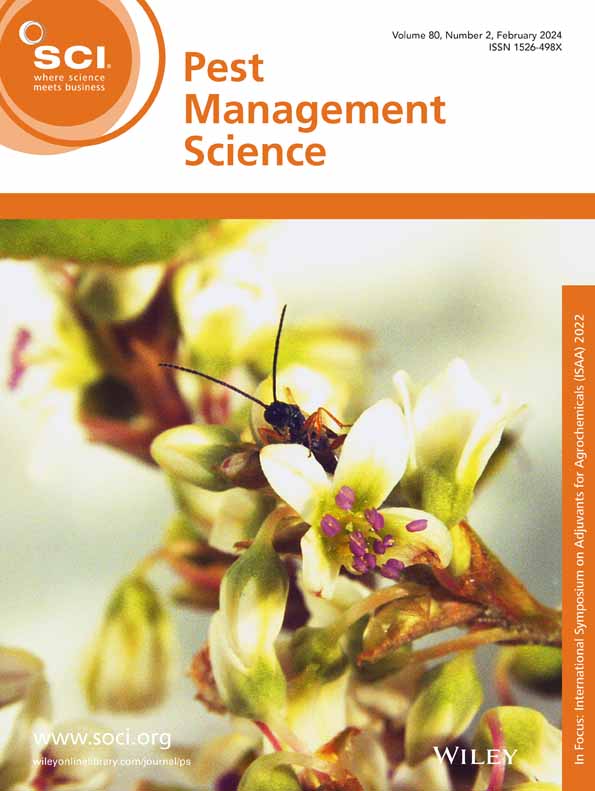Diverse abietane diterpenoids as multifunctional antimicrobial effects from Salvia castanea.
IF 3.8
1区 农林科学
Q1 AGRONOMY
引用次数: 0
Abstract
BACKGROUND Phytopathogenic fungal diseases significantly impact the quality of vegetables and fruits in agriculture. Salvia castanea, a Tibetan medicinal plant, possessed anti-inflammatory, antitumor, and antimicrobial activities. Therefore, we investigated the antimicrobial ingredients from this plant and clarified their protective and curative in plants in detail. RESULTS Bio-guided isolation of Salvia castanea was conducted to obtain 23 abietane diterpenoids, including three new ones (Castanoids A-C). Most compounds exhibited significant antifungal activity against four fungi. Castanoid C (7) showed remarkable inhibition against Sclerotinia sclerotiorum, Valsa mali, and Botrytis cinerea, with median effective concentration (EC50) values of 1.30, 0.84, and 2.40 μg/mL, respectively, outperforming the commercial antifungal agent trifloxystrobin. In vivo, compound 7 demonstrated 100% protective and 82.26 ± 1.07% curative efficiency against Sclerotinia sclerotiorum on rape leaves at 200 μg/mL. At 300 μg/ mL, it effectively controlled tomato rot with 92.65 ± 2.55% protective activity. The observation by transmission electron microscopy disclosed that compound 7 inhibited the growth of fungi by destroying the cell membrane permeability and caused the leakage of cellular components. Additionally, compound 11 exerted potent inhibitory effects against Staphylococcus aureus and Pseudomonas syringae pv. actinidae (Psa) with minimum inhibitory concentration (MIC) value of 6.25 μm, surpassing gentamicin. Its mechanism against Staphylococcus aureus and Psa may also involve membrane damage. CONCLUSION The result highlights the significant antifungal and antibacterial potential of abietane diterpenoids from Salvia castanea, particularly Castanoid C. These findings suggest their broad applicability in agriculture, especially for controlling diseases in rape, apple, and tomato crops. This research provides a foundation for developing natural, effective antimicrobial agents, advancing the field of plant disease management. © 2025 Society of Chemical Industry.鼠尾草中多种枞烷二萜的多功能抗菌作用。
植物病原真菌病害严重影响农业蔬菜和水果的质量。鼠尾草是一种西藏药用植物,具有抗炎、抗肿瘤、抗菌等作用。因此,我们对该植物的抗菌成分进行了研究,详细阐明了其在植物中的保护作用和治疗作用。结果采用生物引导分离方法分离得到23个阿比烷二萜类化合物,其中3个为新化合物(Castanoids A-C)。大多数化合物对四种真菌均表现出显著的抗真菌活性。Castanoid C(7)对菌核菌(Sclerotinia sclerotiorum)、马利枯萎菌(Valsa mali)和灰霉菌(Botrytis cinerea)的抑制作用显著,中位有效浓度(EC50)分别为1.30、0.84和2.40 μg/mL,优于市产抗真菌剂三氟虫胺(trifloxystrobin)。在体内,当浓度为200 μg/mL时,化合物7对油菜菌核菌的保护作用为100%,治疗效果为82.26±1.07%。在300 μg/ mL浓度下,对番茄腐病的防治效果为92.65±2.55%。透射电镜观察发现,化合物7通过破坏细胞膜通透性,导致细胞成分渗漏,从而抑制真菌的生长。此外,化合物11对金黄色葡萄球菌和丁香假单胞菌均有较强的抑制作用。最小抑菌浓度(MIC)为6.25 μm,优于庆大霉素。其对金黄色葡萄球菌和Psa的作用机制也可能与膜损伤有关。结论鼠尾草中阿比烷二萜类化合物具有较强的抗真菌和抗菌活性,特别是在防治油菜、苹果和番茄等作物病害方面具有广泛的应用前景。本研究为开发天然有效的抗菌药物,推进植物病害管理领域的发展奠定了基础。©2025化学工业协会。
本文章由计算机程序翻译,如有差异,请以英文原文为准。
求助全文
约1分钟内获得全文
求助全文
来源期刊

Pest Management Science
农林科学-昆虫学
CiteScore
7.90
自引率
9.80%
发文量
553
审稿时长
4.8 months
期刊介绍:
Pest Management Science is the international journal of research and development in crop protection and pest control. Since its launch in 1970, the journal has become the premier forum for papers on the discovery, application, and impact on the environment of products and strategies designed for pest management.
Published for SCI by John Wiley & Sons Ltd.
 求助内容:
求助内容: 应助结果提醒方式:
应助结果提醒方式:


